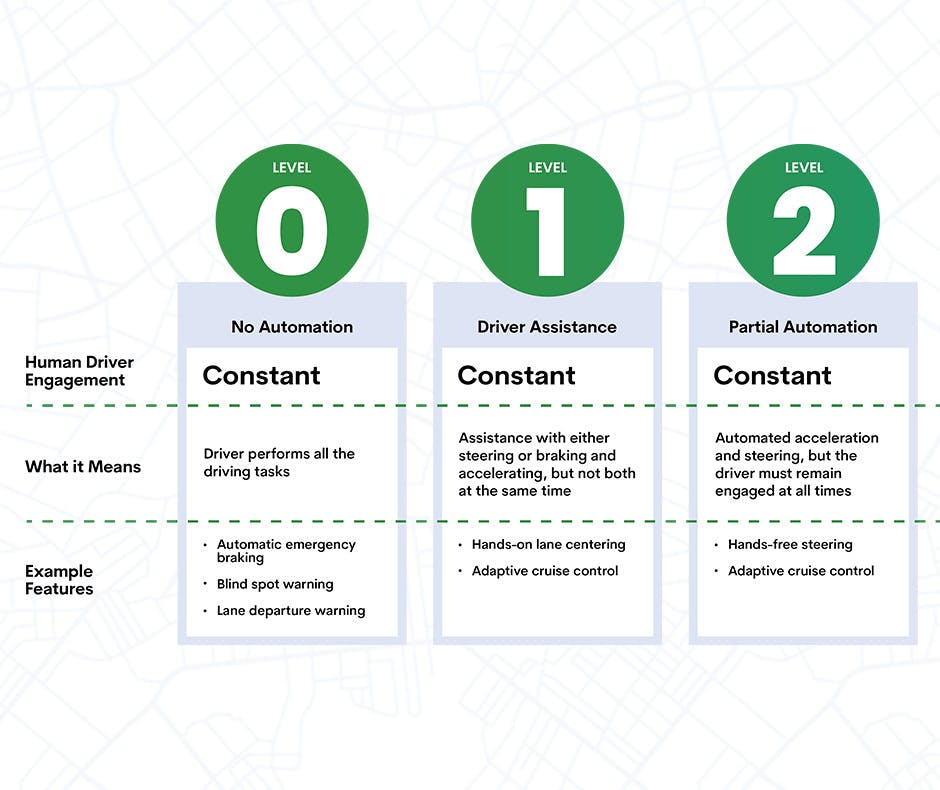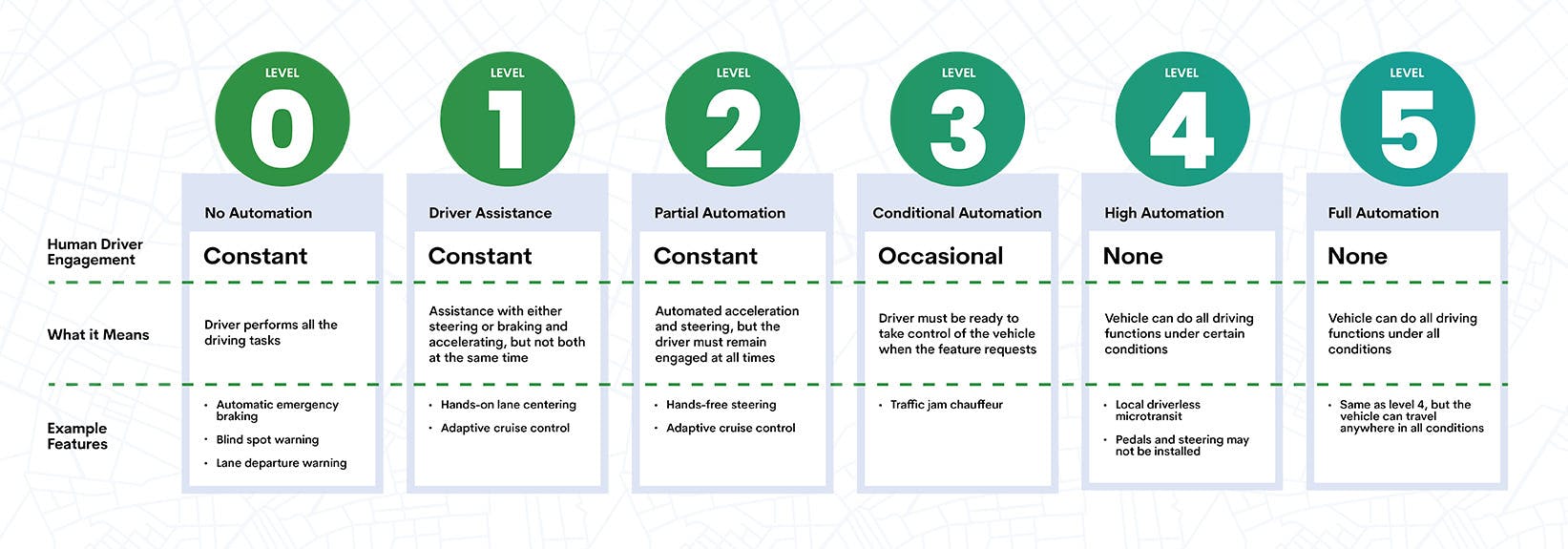MUFG Bank Invests in and Partners with May Mobility to Develop New Fleet Ownership Models
June 16, 2025
The Society of Automotive Engineers defines 6 levels of driving automation. We break down each level and explain why May Mobility’s Level 4 vehicles are in the sweet spot of autonomy.
by Sarah Pressprich Gryniewicz, Strategy Analyst, May Mobility
The Society of Automotive Engineers (SAE) defines 6 levels of driving automation ranging from 0 (fully manual) to 5 (fully autonomous). May Mobility is designing Level 4 vehicles that are in the sweet spot of autonomy– fantastic, world-changing mobility deployed in places where they make the right difference.
While Level 5 autonomy (everywhere, all the time) sounds ideal, if it happens too fast, it will exacerbate our already overloaded transportation networks. Level 4 (many places, most times) is a targeted change that gives us time to update to better and more sustainable transportation.
The SAE developed levels to outline the capabilities and limits of assisted and autonomous driving. While helpful as an explainer– the levels are not really a progression from one stage to another. We see examples of Levels 0 through 4 on the road today.
Level 0, like my old stick shift, relies 100% on the driver to control the vehicle. Levels 1 and 2 also require a driver but have technologies that assist with driving tasks, like cruise control, lane keeping and parking. This makes driving less tedious, but it’s clear the driver is the driver.
Level 3 is a middle ground where the vehicle is in full control in some situations, monitors the road and the traffic, and will inform the driver when he or she must take control. It’s autonomous until it's not.
Levels 4 and 5 are what we think of as fully autonomous—no driver required. Level 4 is fully autonomous for an entire trip in certain conditions and Level 5 is autonomous in all conditions, everywhere (a wonder car!).
We at May Mobility are happily designing Level 4 vehicles as we believe that, at least for the next few decades, Level 4 is just right for getting more people, more mobile, with fewer vehicles clogging the streets.
Level 3 is a challenging middle ground and not the ideal end goal. Situations on the road happen fast and an accident can happen in milliseconds. Requiring a person to switch their focus back to the road, become fully responsible for the vehicle, and make the right decision in an instant is a very tall ask. If expectations for users don’t align with the system’s capabilities, there are large implications for safety! Perhaps with a highly cautious system, excellent user training, and an interface that encourages paying attention, Level 3 could work better, but…that’s what Level 2 does, and does well.
The biggest number is the best, right? Not always. Level 5 autonomy, where you and I would buy a vehicle that goes anywhere, anytime, is a very long way off. The equipment and maps needed are expensive and need to be precisely maintained–making it a poor fit for individual ownership for many years.
And, that’s a good thing. Transportation is a necessity for most of us, but it requires enormous amounts of infrastructure, impacts our climate, and is prone to congestion. We’d all like to have quicker, more convenient travel, but a little friction in the system keeps it (somewhat) balanced.
A personal robot chauffeur that makes it nearly painless to travel is a recipe for an enormous increase in “induced demand,” contributing to sprawl, increased distances, and traffic. Why not travel when you can text, read, watch and sleep while on the go? Great for me… but when we all do it, we all sit in the same congestion.
We would all like a safer, faster, more affordable transportation network– but personal AVs, and really, personal vehicles, are not the answer. In order to improve our cities, reduce carbon and energy usage, and decrease transportation expenses, we need to get better at sharing vehicles. And that’s where Level 4 fits perfectly.
Level 4 is fully autonomous but in geofenced locations or situations. This little bit of fussiness makes it hard for an individual to use effectively but presents a fantastic opportunity for communities to radically expand transit networks. Transit Agencies can strategically deploy Level 4 on-demand zones that get you around your local neighborhood and, for farther trips, connect you to the train or Bus Rapid Transit. Instead of having to own a car (or two or three), you and your neighbors can get around quickly and easily for a small fee.
It’s not always easy or convenient to use transit, but Level 4 vehicles can fill in the gap, unlocking the full potential of a holistic “mobility as a service network.” AVs can provide affordable and sustainable last-mile and lower-density services that are hard to do with a bus or scooter but are needed to make the system work for more people.
Instead of repeating the everywhere-to-everywhere travel patterns we have today, cities can increase access for residents, make connections to other shared services, and reclaim parking and road infrastructure for better uses.
In the next decade, we’ll see increasing numbers of personal vehicles reach Level 2 autonomy. And Level 4 vehicles will change how many of us, and our children, move– with lots of convenience and access, without needing to have our own vehicle.
We’d be delighted to work with you on bringing great autonomy to your city where it can make the right differences for your community and riders. We get cities and transit, can offer ADA wheelchair-accessible vehicles, and can’t wait to help unlock new access for your residents.
Contact us to discuss May Mobility's microtransit benefits and how to bring autonomy to your city.

Sarah Pressprich Gryniewicz is a Senior Strategy Analyst at May Mobility. She focuses on how autonomous vehicles can complement Public Transportation and achieve an equitable and sustainable mobility environment for all members of society. Sarah worked for several years in public transit Southeastern Michigan in strategy leadership, organizational development, and community engagement. Through her time as a Peace Corps Volunteer in Benin, West Africa, she became passionate about infrastructure and “community of place.” She has a BA in History and Economics from the University of Michigan and a Masters of Regional Planning from Cornell University.

Sarah Pressprich Gryniewicz is a Senior Strategy Analyst at May Mobility. She focuses on how autonomous vehicles can complement Public Transportation and achieve an equitable and sustainable mobility environment for all members of society. Sarah worked for several years in public transit Southeastern Michigan in strategy leadership, organizational development, and community engagement. Through her time as a Peace Corps Volunteer in Benin, West Africa, she became passionate about infrastructure and “community of place.” She has a BA in History and Economics from the University of Michigan and a Masters of Regional Planning from Cornell University.

We love meeting transit agencies, cities, campuses, organizations and businesses where they are to explore how our AV solutions can solve their transportation gaps for good. Ready to partner up? Let’s talk.
We love meeting transit agencies, cities, campuses, organizations and businesses where they are to explore how our AV solutions can solve their transportation gaps for good. Ready to partner up? Let’s talk.



